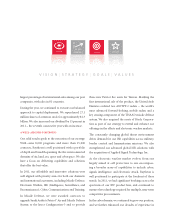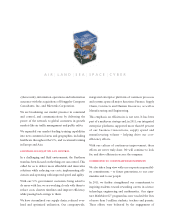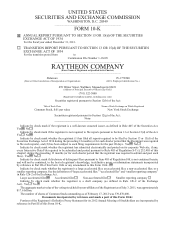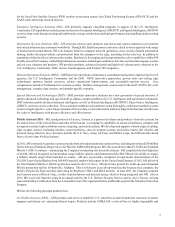Raytheon 2011 Annual Report Download - page 14
Download and view the complete annual report
Please find page 14 of the 2011 Raytheon annual report below. You can navigate through the pages in the report by either clicking on the pages listed below, or by using the keyword search tool below to find specific information within the annual report.6
Sentinel air defense and Firefinder weapon locating radar systems used by the U.S. Army and Marine Corps and over 20 allied
nations; the Battle Control System (BCS) air command and control system used by the U.S. Air Force and Canada; the NATO
Air Command and Control System (ACCS); and the non-TRS U.S. Army's Advanced Field Artillery Tactical Data System
(AFATDS) and Joint Automated Deep Operations Coordination System (JADOCS), which provide for the command and
control of battlefield weapons, effects and operations.
Space and Airborne Systems (SAS)—SAS, headquartered in El Segundo, California, is a leader in the design and development
of integrated systems and solutions for advanced missions, including traditional and non-traditional intelligence, surveillance
and reconnaissance (ISR), precision engagement, unmanned aerial operations and space. Leveraging advanced concepts, state-
of-the-art technologies and mission systems knowledge, SAS provides electro-optical/infrared sensors, airborne radars for
surveillance and fire control applications, lasers, precision guidance systems, processors, electronic warfare systems and space-
qualified systems for civil and military applications. Key customers include the U.S. Navy, Air Force and Army, as well as
classified and international customers.
In 2011, SAS delivered its 300th APG-79 Active Electronically Scanned Array (AESA) radar for integration on the U.S. Navy's
F/A-18E/F Super Hornet and EA-18 Growler. SAS also received approval from the U.S. Air Force to begin low-rate initial
production (LRIP) of the APG-82(V)1 AESA radar for the F-15E radar modernization program. In maritime surveillance
radars, SAS was awarded an LRIP contract to deliver six APY-10 radars for the P-8A Poseidon aircraft and also delivered a
SeaVue XMC radar to the U.S. Customs and Border Protection's Guardian unmanned aircraft system. SAS received contracts
to deliver the AAS-44C(V) Multi-Spectral Targeting System on MH-60R and MH-60S helicopters to the U.S. Navy, deliver
the AN/AAQ-29A forward looking infrared imaging system on a Pave Hawk HH-60G helicopter to the U.S. Air Force, and
develop the processing technology for the Advanced Distributed Aperture System (ADAS) for the U.S. Army. SAS also
received the first production contract from the U.S. Air Force for Airborne Cueing and Exploitation System Hyperspectral
(ACES HY), an airborne tactical hyperspectral sensor. Additionally, SAS received a contract to supply the ALR-69A digital
radar warning receiver on the U.S. Air Force KC-46 tanker program and a contract to supply the ALR-67(V)3 digital radar
warning receiver on the U.S. Navy's F/A-18E/F. In space systems, the National Preparatory Project (NPP) satellite successfully
launched into orbit from California's Vandenberg Air Force Base carrying the SAS Visible Infrared Imager Radiometer Suite
(VIIRS) sensor.
SAS has the following principal product lines:
Intelligence, Surveillance and Reconnaissance Systems (ISRS)—ISRS designs and manufactures sensor, surveillance and
targeting solutions that enable actionable information for strike, persistent surveillance and special mission applications. ISRS
provides maritime and overland surveillance radars, terrain following/terrain avoidance radars, and electro-optical/infrared
sensors to customers including every branch in the DoD, the Department of Homeland Security (DHS) and international
governments. The ISRS portfolio includes the APY-10 radar on the U.S. Navy's P-8A Poseidon, the SeaVue radar on the
Predator Guardian unmanned aerial system (UAS), the Multi-Platform Radar Technology Insertion Program for the U.S. Air
Force's Block 40 Global Hawk, the AAS-44(V) forward looking infrared sensor on the U.S. Navy's MH-60 helicopters, the
Multi-spectral Targeting System on the U.S. Air Force's Reaper and Predator UAS, the DAS-2 on the Army's Gray Eagle
UAS, and the ASQ-228 ATFLIR targeting pod on the F/A-18 Hornet and Super Hornets. ISRS also provides the Enhanced
Integrated Sensor Suite for the Block 20/30 Global Hawk UAS, which enables the Global Hawk to scan large geographic
areas and produce outstanding high-resolution reconnaissance imagery. In addition, ISRS provides integrated solutions for
all tiers of airborne intelligence, surveillance and reconnaissance systems, including the dual mode Synthetic Aperture Radar/
Moving Target Indicator sensor for the ASTOR program for the U.K. Ministry of Defence, which enables high-resolution
images and the monitoring of hostile forces.
Tactical Airborne Systems (TAS)—TAS designs and manufactures cost-effective, high-performance integrated sensor solutions
for tactical and strategic platforms, delivering trusted, actionable information and mission assurance. TAS provides sensors
and integrated sensor systems with advanced fire control radars, electronic warfare and processor technologies to customers
including the U.S. Navy, Marine Corps, and Air Force and international governments. TAS produces radars using AESA
antennas for the U.S. Air Force's F-15 and B-2 aircraft, the U.S. Navy and Royal Australian Air Forces' F/A-18, and the U.S.
Navy's EA-18G. TAS also provides electronic warfare systems for large body and tactical aircraft, helicopters and surface
ships. The TAS electronic warfare portfolio includes towed decoys, radar warning receivers, jammers, missile warning systems
and integrated electronic warfare suites. In addition, TAS' advanced airborne processors form the basis of the secure mission
























